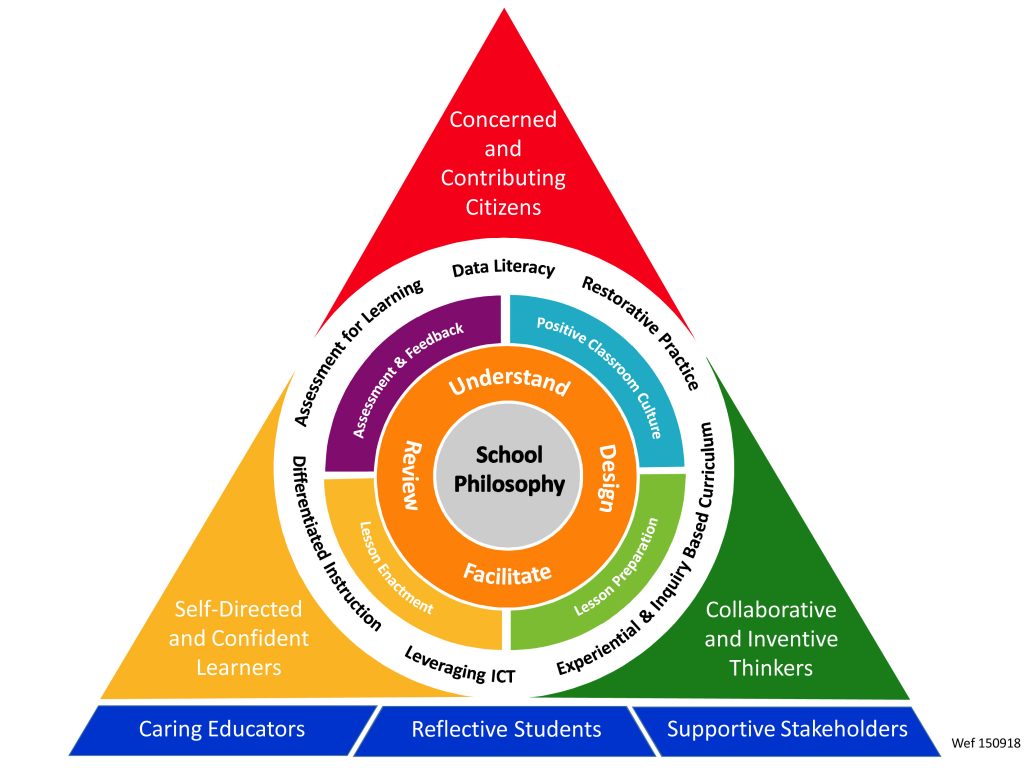Teaching and Learning Framework
Teaching and Learning Framework

Rationale for Review
With the launch of Singapore Teaching Practice (STP) (MOE, Singapore, 2017a) in May 2017, MOE seeks to strengthen teachers’ professional competencies to achieve quality teaching and learning both in and out of the classroom. As part of the school’s review and efforts to streamline her Teaching and Learning (T&L) Framework, Woodlands Ring Secondary School (WRSS) reviewed the existing Framework to better capture the school’s overarching beliefs about and approach to T&L that encapsulates the total curriculum. All this is underpinned by sound pedagogical and theoretical understandings of good teaching that is drawn from the richness of STP. This review is sited against the backdrop of the WRSS’s context and culture to maximise its relevance to the school.
Description of Framework
Central to the framework is the school’s philosophy − We believe that each student is unique and whose potential can be maximised so as to contribute selflessly to society. This aligns with the belief in the Singapore Curriculum Philosophy (SCP) − We believe that every child wants to and can learn.
With this core philosophy in mind, we move to the second ring of curriculum development. Here, we have adopted a cyclical model (Print, 1993) that is adapted from Wheeler (1967). Taking reference from the STP, in WRSS we need to firstly Understand our subject matter and Goals1, before understanding students and how they learn2. We, too, need to understand that many factors may affect our teaching3.
With this understanding, we Design the curriculum and Facilitate4 the learning where the teaching pace, approaches and assessment practices are developmentally appropriate for our learners. After the enactment of the curriculum, it is important to Review if the experienced curriculum achieved its learning objectives by adopting the Reflective Practice Model5.
The next ring is the four core teaching processes detailed in the STP. Embedded in these processes are the teaching areas and actions that aid in the T&L of students.
Considering our school culture, staff and students’ profile, we have identified key focus areas
– Restorative Practice, Differentiated Instruction leveraging the affordances of technology where appropriate, Experiential & Inquiry Based, Assessment for Learning and Data Literacy
– for development in staff competency.
These focus areas were identified after reflecting and evaluating what WRSS has embarked on thus far and what will be strategic in developing staff competence. For instance, since 2005, to create a positive classroom and school tone, WRSS has adopted Restorative Practice as a universal approach in student management.
These focus areas strive to equip and strengthen staff competence in the four core teaching processes. They will be reviewed every three years in WRSS.
We believe that with us as caring educators, working alongside teachable students and in partnership with our supportive stakeholders, we will, through our quality T&L, develop a WRSS student who is a
1. Self-directed and Confident Learner
2. Collaborative and Inventive Thinker
3. Concerned and Contributing Citizen
Footnote:
1 It is necessary for us to understand what and how to teach, in order to make the knowledge and skills accessible to our learners. Only when we understand the subjects’ knowledge bases deeply can we then guide our students effectively and confidently towards deeper conceptual understanding, to develop their disciplinarity thinking and to facilitate the transfer of learning.
2 In addition to understanding their subject matter and goals, teachers need to understand students and how they learn. The development of each of our students differ and is often influenced by social relationships and environments around him/her. Thus, we need to have greater understanding of our learners’ developmental contexts while exploring key theoretical concepts that serve as the basis for effective practices that cultivate positive relationships between teachers, learners and parents.
3 We need to understand the factors that may influence the choices we make in providing quality teaching. This may include the physical and psycho-social environments, teacher-student relationships, student learning needs, and the diverse profiles of students. This knowledge base helps us understand the dynamics that impact the quality of teaching, and understand the ‘why’ and ‘how’ of effective classroom management.
4 We design our curriculum/lesson by adhering to the 3 phases of the SLS Pedagogical Scaffold, a design tool which guides us in deciding on teaching processes for active learning experiences with technology. We then facilitate the planned lessons to ensure there is active learning, promotion of thinking and discussion and demonstration of learning by students. We also monitor and provide the needful feedback to our students.
5 The Reflective Practice Model was referred to during the STP Workshops conducted for school teams in July/Aug 2017. In using the model, we reflect and review our teaching and learning processes by asking What, Why, So What and Now What.
References
MOE, Singapore. (2017a, May 31). The Singapore Teaching Practice.
MOE, Singapore. (2017b, May 31). The Singapore Curriculum Philosophy.
- MOE, Singapore. (2017c, July 31). The Reflective Practice Model.
MOE, Singapore. (2017d, Jan 6). The SLS Pedagogical Scaffold. Retrieved from SLS Design Toolkit.
Print, M. (1993). Curriculum development and design. St. Leonards, NSW, Australia : Allen & Unwin, 1993.
Wheeler, D. K. (1967). Curriculum process. London : University of London, c1967.

